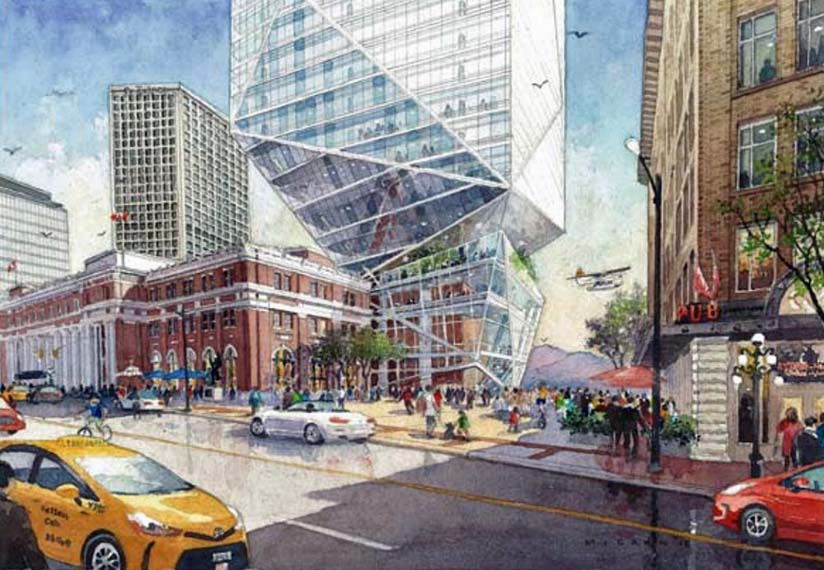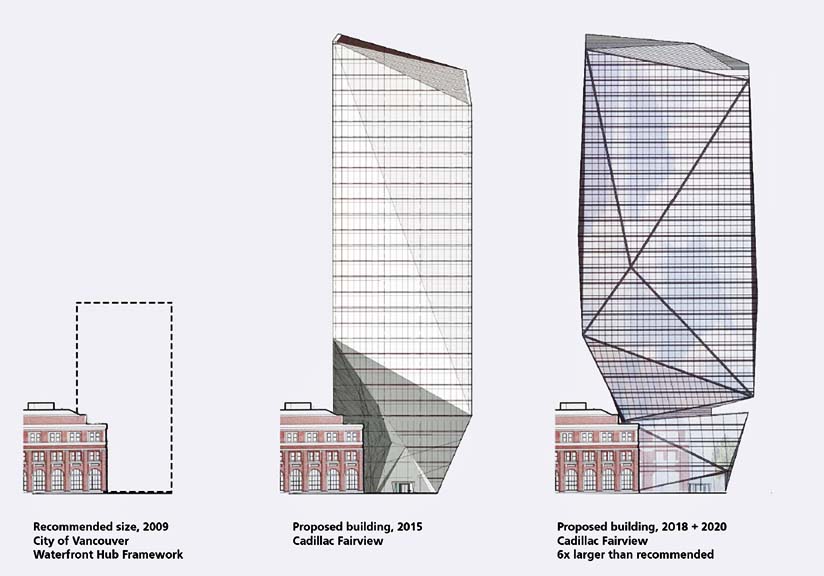
Vancouver British Columbia - Some have named it the Origami Tower.
But a lot of people choose to call it the Ice Pick, a name well deserved.
The building is a deadly spear aimed at the heart of Waterfront Station and blocks future urban design potential for the surrounding site.
Once again, the developer is about to seek approval for what is at least the third iteration of the project.
It never gets any better.
First off, there are real urban design problems with this proposal.
In 2009 the city plotted out a long-term strategy for the Central Waterfront site.
The plan clearly delineated the best massing for the site in question, and a plan to bridge the barrier of the rail lines, all while opening up new parcels for
waterfront development worth billions of dollars.
But I am not writing about that.
I am asking, why does this insult persist?
Its designer is Adrian Smith of Gordon Gill Architecture, a Chicago firm with clients all over the world.
Why do global architects continue to promote ideas that take no heed of locally-significant places, their design potential, and their history?
Already soundly rejected once for its lack of respect for its setting, the Ice Pick cometh again.

Barely changed, its point presses against the figurative throat of the neoclassical Waterfront Station built in 1914.
(Smith and I had debated his design five years ago in the pages of The Tyee.)
I make these objections with some reservation.
I work at a school of architecture, and complaining about something "new", "interesting", creative", and "unprecedented" may
not sit well with my colleagues and our students, who largely favour these qualities.
But in my opinion, disruptive architecture likely to ruin the future potential of the broader site, with no compensatory value other than to celebrate its own
overweening dominance, is simply bad manners.
Adrian Smith has designed the world's tallest building in Dubai so he's on his way to being a starchitect.
But not every great architect need be so dismissive of locale, history, and cultural context.
The great Robert Stern for decades has defined the cutting edge of modernism.
Yet to his credit, Stern is relaxed enough, apparently, to derive inspiration from site circumstances.
Take for example Stern's building now under construction at 14 Fifth Avenue in New York City's Greenwich Village.
Here a constrained site and a cohesive architectural context informed a logical formal motif, one that contributed to, and in a very apparent way, completed
the composition.
It's the opposite of the disruptive strategy used in Vancouver by Smith.
Or much closer to home, Stern's proposal for a "net zero" (meaning producing as much energy as it consumes) residential tower on Alberni
Street.
The return of the Ice Pick is priming Vancouverites to engage yet again in a fight that no doubt will pit those who embrace its shock of the new against those,
like me, who will be labelled philistines.
It's all so unnecessary.
A more modest and suitable configuration would have incurred far less wrath and likely would have led to a negotiated urban design response that unlocked the
potentials of this site.
There was a time in Vancouver, not so long ago, when planners Ray Spaxman, Larry Beasley, and Scot Hein would work with the local architectural community to
ensure that buildings were not just chest thumping celebrations of me-ism, but would make a good contribution to the city.
The Ice Pick does the opposite.
It is the sharp end of placeless globalism poised to bleed away the history of the city.
A city collectively built, mostly for the better, by its planners, its developers, its architects, and its citizens, over recent decades.
Decades that increasingly seem like paradise lost.
Patrick Condon.
(because there was no image with original article)
(usually because it's been seen before)
provisions in Section 29 of the Canadian
Copyright Modernization Act.

